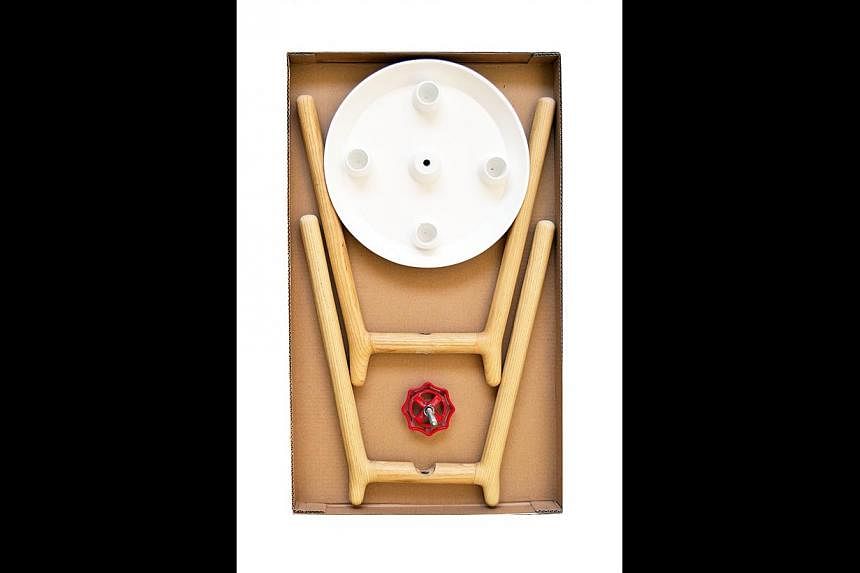They might be just ideas for now, but judges at this year's Red Dot Design Award were wowed by the ingenuity behind five Singapore projects in the design concept category.
Three of the projects were given the Red Dot Award while the other two received honourable mentions at the awards ceremony held at the Red Dot Design Museum Singapore two weeks ago.
The Red Dot Award: Design Concept, which started in 2005, is among the most prestigious design accolades in the world and celebrates prototypes and innovative ideas.
Entries are judged by a jury. The Red Design Award also has two other categories, product design and communication design, which are given out in Germany.
The five Singapore winners faced tough competition when submission in the design concept category opened at the beginning of the year. Out of 4,791 entries from 63 countries in the design concept category, only 304 design concepts received honours. Of these, 202 clinched the Red Dot Award, another 40 were given the Red Dot: Best of the Best award for their exceptional design excellence and 62 got honourable mentions.
Mr Ken Koo, the Asia president of Red Dot Design Award, says: "Every submitted design concept, prototype or about-to-be-produced concept is subject to the same level of jury scrutiny. Only the quality of the idea and design solution counts.
"Competition in this year's Red Dot Award for design concept is tough with a 9 per cent increase in overall entries over the previous year. This did not stop Singapore designers from doing well. Our designers are clearly exerting their influence on the international design stage."
These concepts can be viewed at the Red Dot Design Museum Singapore at 28 Maxwell Road. The Red Dot Design Yearbook can also be bought at the Design Museum Shop for $63.10.
Singapore winners
THE HANDMADE CURE
Won: Red Dot Award in the Relax category
What: Industrial design graduate Tricia Chean has created a crafting kit to help patients who have anxiety problems.
Using a plastic template with grooves, users can weave yarn in various shapes and colours to create their own knitted pieces.
Aside from the satisfaction of making their own item, patients learn to focus and be in control, which helps them in the long run.
Ms Chean, who has renamed the project Bloom, first submitted it during her last year at the National University of Singapore (NUS). The kit has two levels for users - the basic one is designed for beginners and relaxation, while level two requires users to have more focus and can be used for anxiety and stress management.
She says in an NUS News report: "I find crafting relaxing, did some research and found it was scientifically proven that people who knitted and crocheted recovered faster from illness."
REDEYE
Won: Red Dot Award in the Recreation category
What: Disturbed by bulky bicycle locks, cycling enthusiasts and colleagues Ken Ang and Daniel Chua decided to design a sleek system, part of which doubles as a reflective light.
Mr Chua, 27, a designer at a Canadian furniture sourcing company, says: "Bicycle locks are usually bulky and heavy, and cyclists have to carry them around. We wanted something that would minimise the weight and still keep the bicycle well secured."
Together with Mr Ang, 34, a chief designer, they designed a retractable lock system that is easy to use. The main body of the lock, which is made from a magnesium alloy similar to that used in high-end DSLR cameras, is attached to the bicycle frame. Inside the lock is a piece of flat braided cable, made from steel alloy wires encased in weather- resistant polymer. One end is attached to a spring mechanism similar to those used in measuring tapes. The other has a locking bolt.
To unlock the bicycle, the cyclist scrolls through three numbers on the underside of the casing for the right combination so that the flat cable would retract.
For now, the lock remains a 3-D rendered prototype. Mr Chua says: "We have no plans to mass-produce it for now because it's a personal project. We talk about design a lot and about how it can be used to solve problems, but this is our first time getting serious about it and creating a product."
COMMUNI CROSS
Won: Red Dot Award in the Workplace category
What: As a product design student doing prototypes in the workshop, Mr Yang Yang found it difficult to get his classmates' attention whenever he tried to speak with a mask on. If he removed the mask, the dust choked him. It occurred to him that medical staff face a similar problem during surgery. The Shanghai-born 24-year-old, who graduated from Lasalle College of the Arts in May, says: "I wanted a mask which would fix these issues, but still retain its original purpose."
His plastic-rubber version has a built-in audio system. He has applied for a patent and is looking to partner companies to mass-produce it.
SUBMERSIBLE FRESH WATER PARK
Won: Honourable mention in the Green category
What: Looking at Singapore's demand for fresh water, German engineer Holger Doerre set out thinking of a place to store it. Together with architects Julian Ogiwara, William Aitken, Yoon Han and Cecilie Kjeldsen from Eric Parry Studio - the firm is headquarterd in London and has a Singapore office - the group looked under the sea for a solution.
Their concept sees fresh water being stored in inflatable cylinders under the sea, which are held down by concrete rings. The cylinders can be detached and floated when needed.
Mr Ogiwara, 41, director at Eric Parry Studio, says: "There's a lot of land under water which can be harvested to keep fresh water. This concept can be carried out with existing technology. It would create a huge water industry in Singapore."
YODEESA
Won: Honourable mention in the Furniture category
What: Mr Ivan Ho, 36, is a self-confessed Ah Beng who "hangs out at the coffee shop quite a bit". But the time he spent there, and having looked at its foldable tables, inspired him to craft a flat-pack stool.
As the chair is easily assembled in three steps, he named it Yodeesa, which means "one, two, three" in Hokkien.
Mr Ho, who runs his own creative consultancy Tizumuka, which does interior and furniture design among others, says: "The challenge was how to make the stool as flat as the foldable table and without using any tools."
He took about three months to come up with the completed prototype. With a cool, Scandinavian vibe to it, the stool has solid wooden legs, an aluminium seat and is secured with a modified plumbing valve.
It can also be assembled fast.
Mr Ho's record to put it together? Five seconds.









